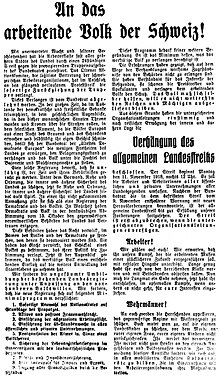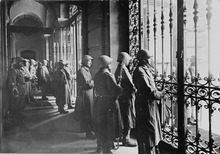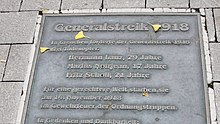
Syndicalism is a revolutionary current within the labor movement that, through industrial unionism, seeks to unionize workers according to industry and advance their demands through strikes, with the eventual goal of gaining control over the means of production and the economy at large through social ownership. Developed in French labor unions during the late 19th century, syndicalist movements were most predominant amongst the socialist movement during the interwar period that preceded the outbreak of World War II.

The Social Democratic Party of Switzerland, or Swiss Socialist Party, is a political party in Switzerland. The SP has had two representatives on the Federal Council since 1960 and received the second-highest number of votes in the 2019 Swiss federal election.
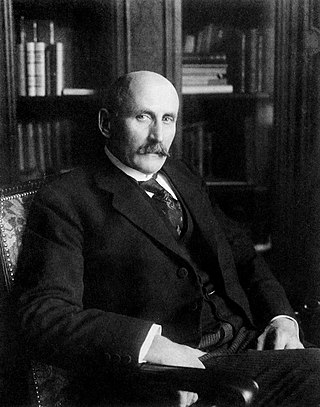
Felix Louis Calonder was a Swiss politician, member of the Swiss Federal Council from 1913 to 1920, and President of the Confederation in 1918. He was affiliated to the Free Democratic Party. During his tenure of office, he held the Department of Home Affairs from 1913 to 1917, and the Political Department from 1918 to 1919. As of 2022, Felix Calonder has been the Federal Council's only native Romansh speaker.
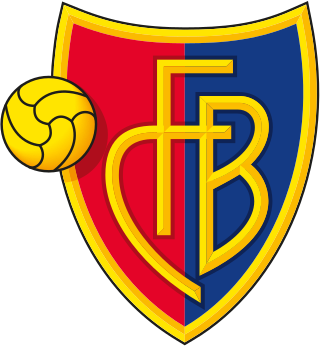
Fussball Club Basel 1893, widely known as FC Basel, FCB, or just Basel, is a Swiss professional football club based in Basel, in the Canton of Basel-Stadt. Formed in 1893, the club has been Swiss national champions 20 times, Swiss Cup winners 13 times, and Swiss League Cup winners once.

The German Revolution of 1918–1919 or November Revolution took place in Germany at the end of the First World War. It began with the downfall of the German Empire and eventually resulted in the establishment of the Weimar Republic. The revolutionary period lasted from November 1918 until the adoption of the Weimar Constitution in August 1919. Among the factors leading to the revolution were the extreme burdens suffered by the German population during the four years of war, the economic and psychological impacts of the German Empire's defeat by the Allies, and growing social tensions between the general population and the aristocratic and bourgeois elite.

Paul Hermann Scherrer was a Swiss physicist. Born in St. Gallen, Switzerland, he studied at Göttingen, Germany, before becoming a lecturer there. Later, Scherrer became head of the Department of Physics at ETH Zurich.

During World War I and World War II, Switzerland maintained armed neutrality, and was not invaded by its neighbors, in part because of its topography, much of which is mountainous. Germany was a threat and Switzerland built a powerful defense. It served as a "protecting power" for the belligerents of both sides, with a special role in helping prisoners of war. The belligerent states made it the scene for diplomacy, espionage, and commerce, as well as being a safe haven for 300,000 refugees.

Leonhard Ragaz (1868–1945) was a Swiss Reformed theologian and, with Hermann Kutter, one of the founders of religious socialism in Switzerland. He was influenced by Christoph Blumhardt. He was married to the feminist and peace activist Clara Ragaz-Nadig.

David Degen is a former Swiss footballer who last played for FC Basel, mostly as a right midfielder, in the Swiss Super League. He is half Dutch as his mother is from the Netherlands. His twin brother Philipp Degen was also a professional football player.

The military history of Switzerland comprises centuries of armed actions, and the role of the Swiss military in conflicts and peacekeeping worldwide. Despite maintaining neutrality since its independence from the Holy Roman Empire in 1499, Switzerland has been involved in military operations dating back to the hiring of Swiss mercenaries by foreign nations, including the Papal States.

Marcel Martin Koller is a Swiss professional football manager and former player who is the current head coach of Al Ahly in the Egyptian Premier League.
Paul Degen was a Swiss illustrator, caricaturist, painter and sculptor. He is mostly known for the cartoons he did for The New York Times and his 34 title illustrations for The New Yorker magazine in the 1970s and 1980s. In 1992 he was awarded the Basel Innovation Prize for inventing the "ROMA birth wheel."
The International Federation of Socialist Young People's Organizations was a federation of youth organizations affiliated with the Socialist parties of the Second International.

The Zimmerwald Conference was held in Zimmerwald, Switzerland, from September 5 to 8, 1915. It was the first of three international socialist conferences convened by anti-militarist socialist parties from countries that were originally neutral during World War I. The individuals and organizations participating in this and subsequent conferences held at Kienthal and Stockholm are known jointly as the Zimmerwald movement.
The International Socialist Commission, also known as the International Socialist Committee or the Berne International was a coordinating committee of socialists parties that adhered to the idea of the Zimmerwald Conference of 1915.

The Spartacus League was a Marxist revolutionary movement organized in Germany during World War I. It was founded in August 1914 as the International Group by Rosa Luxemburg, Karl Liebknecht, Clara Zetkin, and other members of the Social Democratic Party of Germany (SPD) who were dissatisfied with the party's official policies in support of the war. In 1916 it renamed itself the Spartacus Group and in 1917 joined the Independent Social Democratic Party of Germany (USPD), which had split off from the SPD as its left wing faction. During the November Revolution of 1918 that broke out across Germany at the end of the war, the Spartacus Group re-established itself as a nationwide, non-party organization called the "Spartacus League" with the goal of instituting a soviet republic that would include all of Germany. It became part of the Communist Party of Germany (KPD) when it was formed on 1 January 1919 and at that point ceased to exist as a separate entity.

Jenny Thomann-Koller was a gynecologist, pediatrician, and Head of Internal Medicine at the Schweizerische Pflegerinnenschule mit Spital in Zurich. In her dissertation, Beitrag zur Erblichkeitsstatistik der Geisteskranken im Ct. Zürich. Vergleichung derselben mit der erblichen Belastung gesunder Menschen u. dergl., published in 1895, she introduced a control group which challenged the then-popular theory of degeneration and eugenics.

The 1922 Guayaquil general strike was a three-day general work stoppage in the city of Guayaquil, Ecuador, which lasted from 13 to 15 November of that year. The strike began with trolley, electric company and other public utility workers who were inspired by a successful strike by railroad workers in nearby Durán. Workers made demands such as pay increases, shorter hours, safer working conditions, and government control of foreign currency exchange rates.
Anarchism in Switzerland appeared, as a political current, within the Jura Federation of the International Workingmen's Association (IWA), under the influence of Mikhail Bakunin and Swiss libertarian activists such as James Guillaume and Adhémar Schwitzguébel. Swiss anarchism subsequently evolved alongside the nascent social democratic movement and participated in the local opposition to fascism during the interwar period. The contemporary Swiss anarchist movement then grew into a number of militant groups, libertarian socialist organizations and squats.
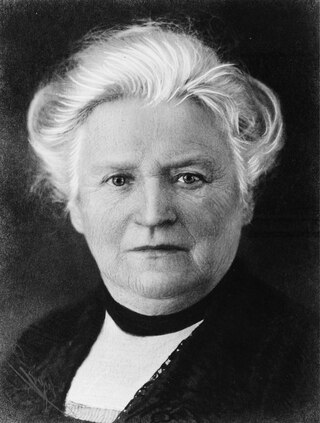
Verena Conzett was a Swiss magazine publisher, labor activist, and women's rights activist. She became the first president of the Swiss Women Workers' Union in 1890. Her own experience as a child factory worker led to her lifelong advocacy for insurance protection and shorter working hours. Following the death of her husband in 1897, Conzett took over his print shop, narrowly escaping bankruptcy. A decade later, she acquired a Linotype typesetting machine and expanded the business into the Conzett & Huber publishing house. In 1908, Conzett launched the illustrated magazine In freien Stunden, and established herself as a successful entrepreneur. Subscriptions to the magazine included accident insurance, which had not yet been mandated by law in Switzerland. Her autobiography, Erstrebtes und Erlebtes, was first published in 1929. Now in its third edition, it has been called "the longest and most literate" of the autobiographies of late 19th-century working-class women written in German. Verena-Conzett-Strasse in Zürich is named after her.


